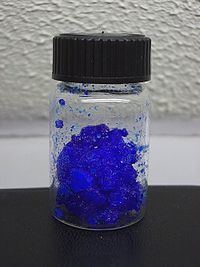Molar mass 163 g/mol Melting point 105 °C | Formula VOSO4 Appearance Blue crystalline solid | |
 | ||
Related compounds | ||
Vanadyl(IV) sulfate, VOSO4, is a inorganic compound of vanadium. This very hygroscopic blue solid is one of the most common sources of vanadium in the laboratory, reflecting its high stability. It features the vanadyl ion, VO2+, which has been called the "most stable diatomic ion."
Contents
Vanadyl sulfate is an intermediate in the extraction of vanadium from petroleum residues, a major commercial source of vanadium. Vanadyl sulfate is a component of some food supplements and experimental drugs. Vanadyl sulfate exhibits insulin-like effects.
Synthesis, structure, and reactions
Vanadyl sulfate is most commonly obtained by reduction of vanadium pentoxide with sulfur dioxide:
V2O5 + 7 H2O + SO2 + H2SO4 → 2 [V(O)(H2O)4]SO4From aqueous solution, the salt crystallizes as the pentahydrate, the fifth water is not bound to the metal in the solid. Viewed as a coordination complex, the ion is octahedral, with oxo, four equatorial water ligands, and a monodentate sulfate.
The V=O bond distance is 160 pm in length, about 50 pm shorter than the V–OH2 bonds. In solution, the sulfate ion dissociates rapidly.
Being widely available, vanadyl sulfate is a common precursor to other vanadyl derivatives, such as vanadyl acetylacetonate:
[V(O)(H2O)4]SO4 + 2C5H8O2 + Na2CO3 → [V(O)(C5H7O2)2] + Na2SO4 + 5 H2O + CO2In acidic solution, oxidation of vanadyl sulfate gives yellow-coloured vanadyl(V) derivatives. Reduction, e.g. by zinc, gives vanadium(III) and vanadium(II) derivatives, which are characteristically green and violet, respectively.
Occurrence in nature
Like most water-soluble sulfates, vanadyl sulfate is only rarely found in nature. Anhydrous form is pauflerite, a mineral of fumarolic origin. Hydrated forms, also rare, include hexahydrate (stanleyite), pentahydrates (minasragrite, orthominasragrite, and anorthominasragrite) and trihydrate - .
Medical research
Vanadyl sulfate has been extensively studied in the field of diabetes research as a potential means of increasing insulin sensitivity; however systematic reviews of the existing literature have found no rigorous evidence that oral vanadium supplementation improves glycaemic control. Treatment with vanadium often results in gastrointestinal side-effects, primarily diarrhea.
Vanadyl sulfate is also marketed as a health supplement, often for body-building. Since vanadium has no biological function in mammals this is a relatively controversial practice. Its effectiveness for body building has not been proven; some evidence suggests that athletes who take it are merely experiencing a placebo effect.
